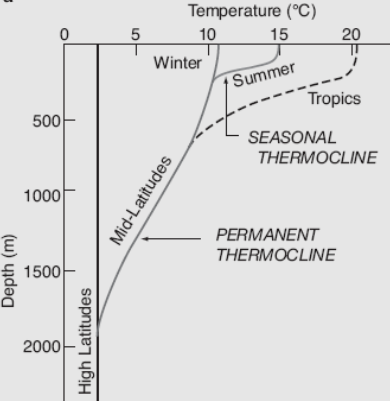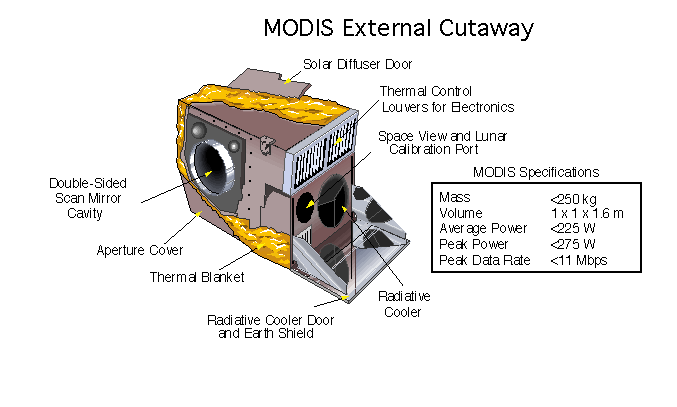 |
Advanced Very-high-resolution Radiometer
The Advanced Very-High-Resolution Radiometer (AVHRR) instrument is a space-borne sensor that measures the reflectance of the Earth in five spectral bands that are relatively wide by today's standards. AVHRR instruments are or have been carried by the National Oceanic and Atmospheric Administration (NOAA) family of polar orbiting platforms ( POES) and European MetOp satellites. The instrument scans several channels; two are centered on the red (0.6 micrometres) and near-infrared (0.9 micrometres) regions, a third one is located around 3.5 micrometres, and another two the thermal radiation emitted by the planet, around 11 and 12 micrometres. The first AVHRR instrument was a four-channel radiometer. The final version, AVHRR/3, first carried on NOAA-15 launched in May 1998, acquires data in six channels. The AVHRR has been succeeded by the Visible Infrared Imaging Radiometer Suite, carried on the Joint Polar Satellite System spacecraft. Operation NOAA has at le ... [...More Info...] [...Related Items...] OR: [Wikipedia] [Google] [Baidu] [Amazon] |
 |
NOAA
The National Oceanic and Atmospheric Administration (NOAA ) is an American scientific and regulatory agency charged with forecasting weather, monitoring oceanic and atmospheric conditions, charting the seas, conducting deep-sea exploration, and managing fishing and protection of marine mammals and endangered species in the US exclusive economic zone. The agency is part of the United States Department of Commerce and is headquartered in Silver Spring, Maryland. History NOAA traces its history back to multiple agencies, some of which are among the earliest in the federal government: * United States Coast and Geodetic Survey, formed in 1807 * Weather Bureau of the United States, formed in 1870 * Bureau of Commercial Fisheries, formed in 1871 (research fleet only) * Coast and Geodetic Survey Corps, formed in 1917 The most direct predecessor of NOAA was the Environmental Science Services Administration (ESSA), into which several existing scientific agencies such as the ... [...More Info...] [...Related Items...] OR: [Wikipedia] [Google] [Baidu] [Amazon] |
 |
National Atlas
The ''National Atlas of the United States'' was an atlas published by the United States Department of the Interior from 1874 to 1997. Older editions were printed, but the most recent edition was available online. Since it is a publication of the United States government, the atlas and its maps are in the public domain within the U.S. According to the U.S. National Atlas website, this atlas "provided a comprehensive, maplike view into the enormous wealth of geospatial and geostatistical data collected for the United States." Its purpose was also to increase "geographic knowledge and understanding and to foster national self-awareness." Information used to develop the ''National Atlas of the United States'' was also used in conjunction with Canadian and Mexican information to produce continental-scale tools such as the ''North American Environmental Atlas''. The online ''National Atlas of the United States'' contained thousands of printable maps, fully documented digital cartog ... [...More Info...] [...Related Items...] OR: [Wikipedia] [Google] [Baidu] [Amazon] |
 |
Ocean Temperature
The ocean temperature plays a crucial role in the global climate system, ocean currents and for marine habitats. It varies depending on depth, geographical location and season. Not only does the temperature differ in seawater, so does the salinity. Warm surface water is generally saltier than the cooler deep or polar waters. In polar regions, the upper layers of ocean water are cold and fresh. Deep ocean water is cold, salty water found deep below the surface of Earth's oceans. This water has a uniform temperature of around 0-3°C. The ocean temperature also depends on the amount of solar radiation falling on its surface. In the tropics, with the Sun nearly overhead, the temperature of the surface layers can rise to over . Near the poles the temperature in equilibrium with the sea ice is about . There is a continuous large-scale circulation of water in the oceans. One part of it is the thermohaline circulation (THC). It is driven by global density gradients created by su ... [...More Info...] [...Related Items...] OR: [Wikipedia] [Google] [Baidu] [Amazon] |
|
NOAA-20
NOAA-20, designated JPSS-1 prior to launch, is the first of the United States National Oceanic and Atmospheric Administration's latest generation of U.S. polar-orbiting, non-geosynchronous, environmental satellites called the Joint Polar Satellite System. NOAA-20 was launched on 18 November 2017 and joined the Suomi NPP, Suomi National Polar-orbiting Partnership satellite in the same orbit. NOAA-20 operates about 50 minutes behind Suomi NPP, allowing important overlap in observational coverage. Circling the Earth from pole-to-pole, it crosses the equator about 14 times daily, providing full global coverage twice a day. This gives meteorologists information on "atmospheric temperature and moisture, clouds, sea-surface temperature, ocean color, sea ice cover, volcanic ash, and fire detection" so as to enhance weather forecasting including hurricane tracking, post-hurricane recovery by detailing storm damage and mapping of power outages. The project incorporates five instruments, ... [...More Info...] [...Related Items...] OR: [Wikipedia] [Google] [Baidu] [Amazon] |
|
 |
Suomi NPP
The Suomi National Polar-orbiting Partnership (Suomi NPP), previously known as the National Polar-orbiting Operational Environmental Satellite System Preparatory Project (NPP) and NPP-Bridge, is a weather satellite operated by the United States National Oceanic and Atmospheric Administration (NOAA). It was launched in 2011 and is currently in operation. Suomi NPP was originally intended as a pathfinder for the National Polar-orbiting Operational Environmental Satellite System (NPOESS) program, which was to have replaced NOAA's Polar Operational Environmental Satellites (POES) and the U.S. Air Force's Defense Meteorological Satellite Program (DMSP). Suomi NPP was launched in 2011 after the cancellation of NPOESS to serve as a stop-gap between the POES satellites and the Joint Polar Satellite System (JPSS) which will replace them. Its instruments provide climate measurements that continue prior observations by NASA's Earth Observing System (EOS). Name The satellite is name ... [...More Info...] [...Related Items...] OR: [Wikipedia] [Google] [Baidu] [Amazon] |
 |
VIIRS
The Visible Infrared Imaging Radiometer Suite (VIIRS) is a sensor designed and manufactured by the Raytheon Company on board the polar-orbiting Suomi National Polar-orbiting Partnership (Suomi NPP), NOAA-20, and NOAA-21 weather satellites. VIIRS is one of five key instruments onboard Suomi NPP, launched on October 28, 2011. VIIRS is a whiskbroom scanner radiometer that collects imagery and radiometric measurements of the land, atmosphere, cryosphere, and oceans in the visible and infrared bands of the electromagnetic spectrum. VIIRS is capable of generating two data processing streams that result in two different sets of land products, with global coverage every 14 hours. One is produced by NOAA, and provides operational data for use by the National Weather Service. These are known as environmental data records (EDRs). The other stream is from NASA, and is intended to contribute to the larger scientific community. These are known as Earth System Data Records (ESDRs). VIIRS's m ... [...More Info...] [...Related Items...] OR: [Wikipedia] [Google] [Baidu] [Amazon] |
 |
MODIS
The Moderate Resolution Imaging Spectroradiometer (MODIS) is a satellite-based sensor used for earth and climate measurements. There are two MODIS sensors in Earth orbit: one on board the Terra (EOS AM) satellite, launched by NASA in 1999; and one on board the Aqua (EOS PM) satellite, launched in 2002. Since 2011, MODIS operations have been supplemented by VIIRS sensors, such as the one aboard Suomi NPP. The systems often conduct similar operations due to their similar designs and orbits (with VIIRS data systems deisgned to be compatible with MODIS), though they have subtle differences contributing to similar but not identical uses. The MODIS instruments were built by Santa Barbara Remote Sensing. They capture data in 36 spectral bands ranging in wavelength from 0.4 μm to 14.4 μm and at varying spatial resolutions (2 bands at 250 m, 5 bands at 500 m and 29 bands at 1 km). Together the instruments image the entire Earth every 1 to 2 days. They are designed ... [...More Info...] [...Related Items...] OR: [Wikipedia] [Google] [Baidu] [Amazon] |
|
Radiative Transfer Model
An atmospheric radiative transfer model, code, or simulator calculates radiative transfer of electromagnetic radiation through a planetary atmosphere. Methods At the core of a radiative transfer model lies the radiative transfer equation that is numerically solved using a solver such as a discrete ordinate method or a Monte Carlo method. The radiative transfer equation is a monochromatic equation to calculate radiance in a single layer of the Earth's atmosphere. To calculate the radiance for a spectral region with a finite width (e.g., to estimate the Earth's energy budget or simulate an instrument response), one has to integrate this over a band of frequencies (or wavelengths). The most exact way to do this is to loop through the frequencies of interest, and for each frequency, calculate the radiance at this frequency. For this, one needs to calculate the contribution of each spectral line for all molecules in the atmospheric layer; this is called a ''line-by-line'' calculatio ... [...More Info...] [...Related Items...] OR: [Wikipedia] [Google] [Baidu] [Amazon] |
|
 |
Moderate-Resolution Imaging Spectroradiometer
The Moderate Resolution Imaging Spectroradiometer (MODIS) is a satellite-based sensor used for earth and climate measurements. There are two MODIS sensors in Geocentric orbit, Earth orbit: one on board the Terra (satellite), Terra (Earth Observing System, EOS AM) satellite, launched by NASA in 1999; and one on board the Aqua (satellite), Aqua (EOS PM) satellite, launched in 2002. Since 2011, MODIS operations have been supplemented by VIIRS sensors, such as the one aboard Suomi NPP. The systems often conduct similar operations due to their similar designs and orbits (with VIIRS data systems deisgned to be compatible with MODIS), though they have subtle differences contributing to similar but not identical uses. The MODIS instruments were built by Santa Barbara Remote Sensing. They capture data in 36 spectral bands ranging in wavelength from 0.4 μm to 14.4 μm and at varying spatial resolutions (2 bands at 250 m, 5 bands at 500 m and 29 bands at 1 km). Together th ... [...More Info...] [...Related Items...] OR: [Wikipedia] [Google] [Baidu] [Amazon] |
|
International Satellite Cloud Climatology Project
The International Satellite Cloud Climatology Project (ISCCP) was established as the first project of the World Climate Research Program (WCRP). Since its inception in 1982, there have been two phases, 1983–1995 and 1995–2009. The project is responsible for collection and analysis of weather satellite radiance measurements. It infers clouds' global distribution and properties, along with their diurnal, seasonal, and interannual variations. The results are studied to understand clouds in climate, including their effects on radiative energy exchanges, plus their role in the global water cycle. These datasets provide a systematic view of cloud behavior. The ISCCP headquarters were located at the Goddard Institute for Space Studies in New York City. ISCCP data is stored at the ISCCP Central Archive and at NASA. While the data are typically used for climate study, they are also a valuable resource for astronomical pursuits. ISCCP was headed by William B. Rossow. From 1983, insti ... [...More Info...] [...Related Items...] OR: [Wikipedia] [Google] [Baidu] [Amazon] |